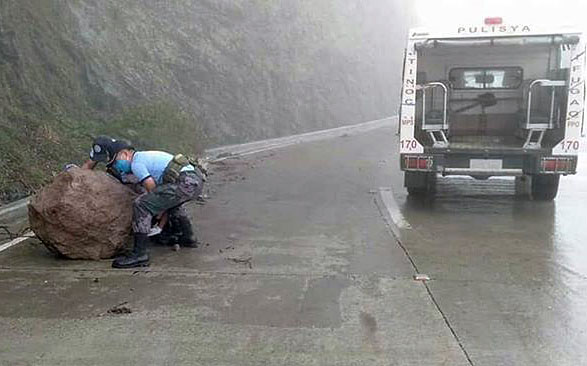
ROCKSLIDE Policemen in Tinoc, Ifugao, move a boulder that fell on the Tinoc-Buguias Road due to the heavy rains dumped by Typhoon “Ambo.” | PHOTO COURTESY OF TINOCMUNICIPAL POLICE STATION
Typhoon “Ambo” (international name: Vongfong) has damaged at least P185 million in produce, affected almost 41,000 farmers in three regions, and left a wide swath of destruction that displaced thousands and claimed four lives in Eastern Visayas.
“While we are afraid of this (new coronavirus disease) COVID-19, I am more afraid that our people will perish because of hunger,” said Gov. Ben Evardone of Eastern Samar, where Ambo made the first of six landfalls on May 14.
The Category 3 storm made two other landfalls in Northern Samar, two in Masbate on May 15 and one in Quezon before moving on to the West Philippine Sea.
It has since dissipated into a low-pressure area in waters off Batanes Island. The Philippine Atmospheric, Geophysical and Astronomical Services Administration said it would likely move out of Philippine territory this week.
But Evardone said Eastern Samar needs to declare a state of calamity to hasten the release of funds and distribution of relief assistance to affected families.
“We need an immediate intervention to feed the people there for they have practically nothing to eat,” said Evardone who visited Jipapad town, the municipality hit hardest by Ambo.
‘Heart-wrenching’
“It was a heart-wrenching scenario of dispirited families gathering their drowned animals, like carabaos, pigs and chickens, and some harvesting felled coconuts for a quick meal,” the governor said.
The Department of Agriculture (DA) said initial estimates on reported damage and losses to rice, corn, high-value crops and livestock in the regions of Calabarzon, Bicol and Eastern Visayas, amounted to P185.83 million, affecting 40,872 farmers.
Around 9,977 hectares of agricultural lands were wrecked, with a volume loss estimated at 10,366 metric tons (MT).
In Bicol region alone, DA Regional Director Rodel Tornilla said corn farmers were estimated to have lost P52 million in produce. Rice farmers recorded an initial production loss of 1,149 MT valued at P17.5 million.
High-value crops such as fruits and vegetables were also damaged. Roughly 201 hectares were destroyed amounting to P10 million. Meanwhile, livestock losses were valued at P101,500.
State of calamity
In Maslog, Eastern Samar, a town of 1,353 households, more than 800 houses were damaged along with several municipal facilities while a suspension bridge was destroyed, said Mayor Rack Santiago, adding that an estimated P42 million was needed for repairs.
“Ambo caught us by surprise because nobody expected that it will hit us. Nobody even was able to observe social distancing when many families sought shelter in our evacuation centers,” Santiago said.
“[Townsfolk’s] newly harvested rice, coconuts and corn would have tied them over until fiesta but they’re gone now,” he added.
In Oras, Eastern Samar, more than 10,500 families need food and housing assistance.
Mayor Vivian Alvarez estimated damage to their coconut industry at around P1 billion while losses in the rice production and fishing industries in the municipality amounted to around P500 million and P20 million respectively.
In Catubig, Northern Samar, the municipal council declared a state of calamity after damage to crops and infrastructure reached at least P107.4 million.
The report of the town disaster council showed that 9,030 families, consisting of 37,153 individuals, were affected by Ambo. “We have already spent around P2.7 million for our COVID-19 response and here comes Ambo which is the most destructive typhoon to hit Catubig in years,” said Mark Romulo Lluz, the town’s disaster management officer.
—WITH A REPORT FROM JHESSET O. ENANO